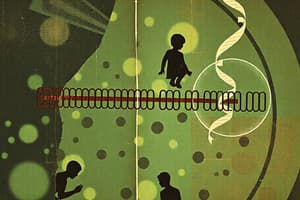Podcast
Questions and Answers
What process occurs when homologous pairs of chromosomes exchange parts?
What process occurs when homologous pairs of chromosomes exchange parts?
- Trisomy
- Nondisjunction
- Chromosomal alignment
- Crossing over (correct)
What genetic condition is characterized by an atypical number of chromosomes resulting from improper separation during meiosis?
What genetic condition is characterized by an atypical number of chromosomes resulting from improper separation during meiosis?
- Trisomy
- Monosomy
- Aneuploidy (correct)
- Polyploidy
In a pedigree chart, what is primarily demonstrated?
In a pedigree chart, what is primarily demonstrated?
- The alignment of homologous chromosomes
- The movement of chromosomes across generations (correct)
- The complete set of chromosomes in an organism
- The random nature of chromosomal crossover
Which term describes having one extra chromosome?
Which term describes having one extra chromosome?
What distinguishes aneuploidy from polyploidy?
What distinguishes aneuploidy from polyploidy?
What is the primary purpose of meiosis in organisms?
What is the primary purpose of meiosis in organisms?
During which phase of meiosis do homologous chromosomes separate?
During which phase of meiosis do homologous chromosomes separate?
What characterizes sister chromatids during meiosis?
What characterizes sister chromatids during meiosis?
What is a zygote?
What is a zygote?
Which statement correctly defines homologous chromosomes?
Which statement correctly defines homologous chromosomes?
What happens to the chromosome number during fertilization?
What happens to the chromosome number during fertilization?
Which phases are involved in interphase before starting meiosis?
Which phases are involved in interphase before starting meiosis?
How many haploid gametes can be produced from one diploid cell through meiosis?
How many haploid gametes can be produced from one diploid cell through meiosis?
Flashcards
Crossing Over
Crossing Over
The exchange of genetic material between homologous chromosomes during meiosis, resulting in new combinations of alleles.
Nondisjunction
Nondisjunction
The failure of chromosomes to separate properly during meiosis, leading to gametes with an abnormal number of chromosomes.
Trisomy
Trisomy
A condition in which a cell has one extra chromosome (one more than the normal count).
Monosomy
Monosomy
Signup and view all the flashcards
Aneuploidy
Aneuploidy
Signup and view all the flashcards
Homologous Chromosomes
Homologous Chromosomes
Signup and view all the flashcards
Diploid (2n)
Diploid (2n)
Signup and view all the flashcards
Haploid (n)
Haploid (n)
Signup and view all the flashcards
Meiosis I
Meiosis I
Signup and view all the flashcards
Meiosis II
Meiosis II
Signup and view all the flashcards
Gametes
Gametes
Signup and view all the flashcards
Zygote
Zygote
Signup and view all the flashcards
Prophase I
Prophase I
Signup and view all the flashcards
Study Notes
Chromosome Structure and Numbering
- Chromosomes are numbered based on length, with chromosome 1 being the longest.
- Chromosomes can be identified by their length, banding pattern, and centromere position.
- Each chromosome has a short (p) arm and a long (q) arm.
- The location of a gene is indicated using a notation like 12p3 (chromosome 12, p arm, band 3).
Mitosis vs. Meiosis
- Mitosis produces genetically identical daughter cells used for body cell division.
- Meiosis produces gametes (sex cells) with half the number of chromosomes as the parent cell.
Diploid and Haploid Cells
- Human somatic cells are diploid (2n = 46).
- Homologous chromosomes are diploid, having the same length, position, and gene sequence, but potentially different alleles.
- One homologous chromosome is inherited from each parent.
- Meiosis produces haploid cells (n = 23), such as sperm and eggs in humans.
- This halving of chromosome number is crucial to maintain the correct chromosome count across generations.
Meiosis Phases
- Meiosis involves two divisions (Meiosis I and Meiosis II), resulting in four haploid cells from one diploid cell.
- Meiosis I separates homologous chromosomes, and Meiosis II separates sister chromatids.
- Meiosis 1: Homologous chromosome pairs separate
- Meiosis 2: Sister chromatids of each chromosome separate, leading to four haploid cell gametes
Crossing Over
- During prophase I, homologous chromosomes pair up to undergo crossing over.
- Crossing over involves swapping segments of DNA between homologous chromosomes.
- The precise location of crossovers is random, leading to genetically diverse gametes.
Fertilization and Zygotes
- Sperm and egg cells, which are haploid, unite in fertilization.
- The combination results in a diploid zygote.
Chromosomal Inheritance and Pedigrees
- Pedigrees are family trees used to trace patterns of inheritance.
- Patterns of inheritance can be analysed by following chromosome movement across generations.
Nondisjunction and Aneuploidy
- Nondisjunction is an error where chromosomes fail to properly separate during meiosis.
- This results in gametes with either an extra chromosome (trisomy) or a missing chromosome (monosomy).
- Aneuploidy refers to any abnormal chromosome number (more or less than normal).
Karyograms
- Karyograms are used to visualize an organism’s chromosomes.
- They can help identify the presence of chromosomal abnormalities, like trisomy or monosomy.
Studying That Suits You
Use AI to generate personalized quizzes and flashcards to suit your learning preferences.
Description
Explore the fundamentals of chromosome structure, numbering, and the differences between mitosis and meiosis. This quiz will test your understanding of diploid and haploid cells and their significance in human genetics. Prepare to dive into the essential concepts that govern cellular reproduction and genetic inheritance.




